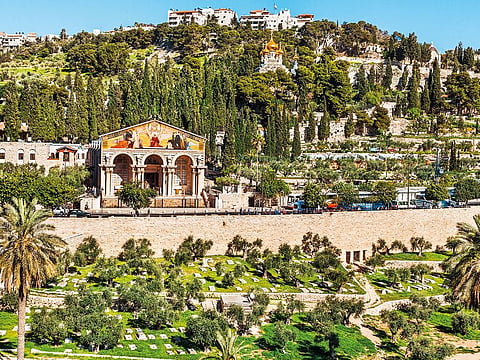6 places of faith to visit in Israel
There is a plethora of sacred spaces celebrating the similarities of the Abrahamic people

The signing of the historic Abraham Accord in Washington DC marks a new story of cooperation between the UAE and Israel, just as last year’s announcement of the Abrahamic Family House on Abu Dhabi’s Saadiyat Island shepherded a chapter of coexistence.
Judaism, Christianity, and Islam are the largest Abrahamic religions – along with followers of the Druze and Baha’i faiths, and Rastafarianism – and for all three, the prophet Abraham’s willingness to sacrifice his son Issac to god is a lodestone of their faith. Muslims who refer to him as Ibrahim venerate his obedience at Eid Al Adha, Christians look upon it as a foreshadow of the fate of Jesus, and Jews uphold the belief that he has been pledged the promised land.
Across Israel, there is a plethora of sacred spaces that celebrate the many other similarities of the Abrahamic people – in sacred tradition, spiritual belief, and cultural practice.
Mount of Olives
Overlooking the Old City and named for the olive groves that once covered its slopes, the mount offers vast vistas for Christian contemplation of Jesus’ prophetic visions, teachings, arrest, and later, his ascension. Concurrently, it is also the venue of Judaism’s oldest and most important graveyard, and the Tomb of the Prophets. Views from its slopes include the stunning solitary gold sphere of the Dome of the Rock, and the seven golden onion domes of the Russian Church of Mary Magdalene.
Bethany
Known by its classical name Bethany or its Arabic interpretation Al Azariya (the Place of Lazarus), this name crops up no less than 11 times in the Bible, of which the most popular reference is as the home of the siblings Mary and Martha and their brother Lazarus who was raised from the dead in one of Jesus’ miracles. Both church and mosque mark the site, located almost next to each other.
Bethlehem
Contrary to popular belief, the ancient city of Bethlehem is first mentioned in the Bible not as Jesus’ birthplace, but as the site of Rachael’s Tomb, just as it is in the Jewish Tanakh and in Muslim literature. Although the exact location is contested, the tomb at the entrance of Bethlehem is a holy landmark in the Jewish tradition, and also known as Bilal bin Rabah Mosque. In the city, the Grotto inside the Church of the Nativity, identified as the manger where Jesus was born, has attracted millions of Christian pilgrims for centuries. Across the square from this ancient church is the Mosque of Omar, the only mosque in Bethlehem, built on land donated by Jerusalem’s Greek Orthodox Church.
Haifa
Israelis often quip that Haifa works, Jerusalem prays, Tel Aviv plays and this underscores Haifa’s reputation as a city of industry. The third-largest city in Israel is also notably heterogenous with a mixed citizenry of Israeli Jews, Arab and non-Arab Christians, Muslims that include Ahmadis, and Druze and Baha’is. Haifa is home to the Shrine of the Bab, burial place of the Bab, founder of the Babi faith and one of the central figures of the Baha’i faith. This second-holiest place on earth for the Baha’i close to the Baha’i World Centre, the global spiritual and administrative centre of their faith, located on Mount Carmel. In turn, Mount Carmel is considered a mountain-residence of the Prophet Elijah in mainstream Christian, Muslim, and Jewish traditions.
Nazareth
Known as the Arab capital of Israel and the childhood home of Jesus, Nazareth is home to dozens of monasteries, churches and mosques. The two most prominent are the Basilica of the Annunciation, which Catholic tradition reveres as the house of Mary where the angel Gabriel appeared to her in a dream, and the pencil-shaped minaret-topped White Mosque.
The Arabic name for Nazareth is An Nasira and in the Quran, Christians are referred to as Nasara, reflecting the Arab tradition of according people a name denoting where a person comes from, in either geographical or tribal terms. Nasaras are those who follow Jesus of Nazareth.
The Old City of Jerusalem
Cited in all three major Abrahamic holy books, Jerusalem is one of the oldest cities. Inside the modern city, a walled area called the Old City is home to one of the world’s densest concentration of holy sites. Christians believe The Church of the Holy Sepulchre is where Jesus was crucified, buried and resurrected. Jews pray at their holiest site, the Western Wall or Wailing Wall, part of an ancient stone retaining wall of Temple Mount on which their holiest temple once stood. The Temple Mount is known to Muslims as Haram Al Sharif, the noble sanctuary. Islam’s third-holiest site, Al Aqsa Mosque (the place where Prophet Mohammed, Peace be upon him, arrived from Makkah during his night journey) is adjacent to the Dome of the Rock (a shrine, from whence he ascended to heaven). The Old City became a Unesco World Heritage Site list in 1981.
Sign up for the Daily Briefing
Get the latest news and updates straight to your inbox



